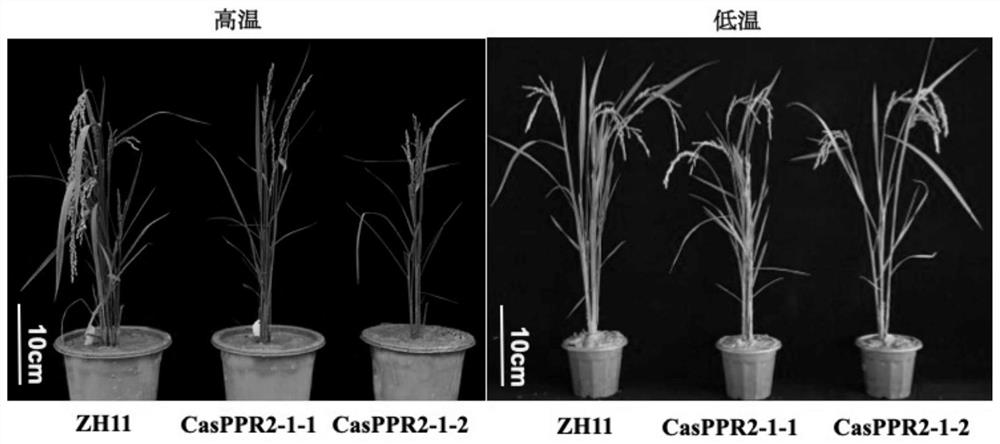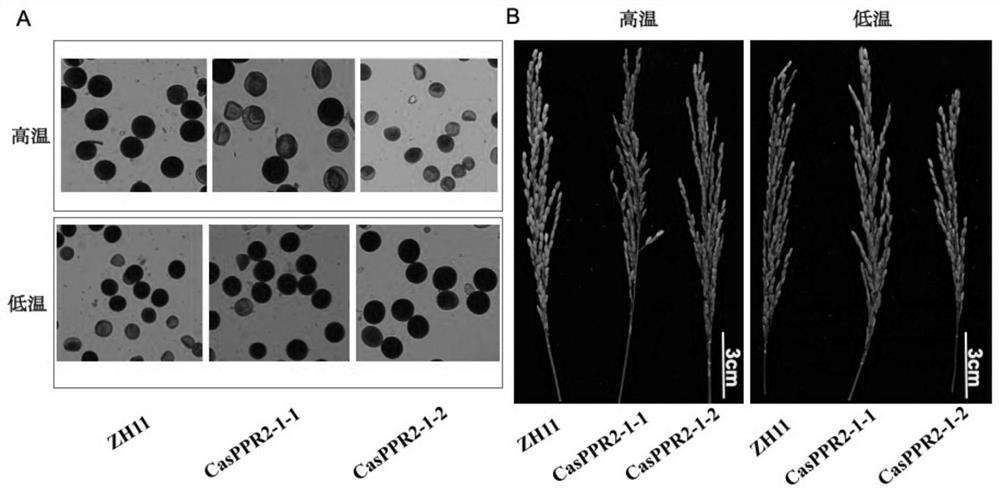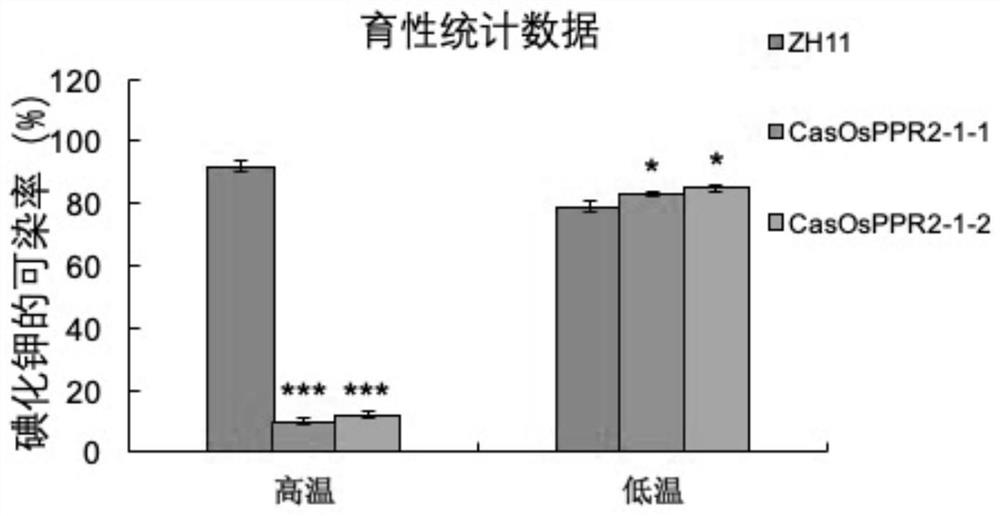Application of rice osppr2-1 gene in constructing plants with improved fertility under natural conditions
A rice and gene technology, applied in the fields of application, genetic engineering, plant gene improvement, etc., to achieve good regulation effect, less damage, and increased seed setting rate
- Summary
- Abstract
- Description
- Claims
- Application Information
AI Technical Summary
Problems solved by technology
Method used
Image
Examples
Embodiment 1
[0045] Example 1 Construction of Gene OsPPR2-1 Mutant Rice Plants
[0046] In the japonica rice variety Zhonghua 11, the CRISPR / Cas9 system mutation OsPPR2-1 (Os02g0110400 or LOC_Os02g0202) was used to obtain plants sensitive to natural environment temperature fertility. The specific method is as follows:
[0047] 1. Construction method
[0048] (1) Target sequence design:
[0049] Target-PPR2-1-U3 (SEQ ID NO.5): GGTGGTTCCGGCGTGTCGA
[0050] (2) Construction of pU3-gRNA vector containing Target-PPR2-1-U3:
[0051] First synthesize target adapter primer pairs with cohesive ends:
[0052] Target-PPR2-1-U3 F (SEQ ID NO. 6): GGCAGGTGGTTCCGGCGTGTCGA,
[0053] Target-PPR2-1-U3 R (SEQ ID NO. 7): AAACTCGACACGCCGGAACCACC;
[0054] After denaturing the adapter primer, move it to room temperature to cool to complete annealing, and link the annealed primer to the digested pU3-gRNA carrier; the positive plasmid is verified by PCR amplification and sequencing. The pU3-gRNA vector cont...
Embodiment 2
[0066] Example 2 Constructing Gene OsPPR2-1 Mutant Rice Plants
[0067] In the japonica rice variety Zhonghua 11, the CRISPR / Cas9 system mutation OsPPR2-1 (Os02g0110400 or LOC_Os02g0202) was used to obtain plants with increased yield. The specific method is as follows:
[0068] 1. Construction method
[0069] (1) Target sequence design:
[0070] Target-OsPPR2-1-U6 (SEQ ID NO. 15): CTGAAGCCGGCGCGACGGT
[0071] (2) Construction of pU6-gRNA vector containing Target-PPR2-1-U6 fragment,
[0072] First synthesize target adapter primer pairs with cohesive ends:
[0073] Target-PPR2-1-U6 F (SEQ ID NO. 16): GCCGCTGAAGCCGGCGCGACGGT,
[0074] Target-PPR2-1-U6 R (SEQ ID NO. 17): AAACACCGTCGCGCCGGCTTCAG;
[0075] Denature the adapter primer and move it to room temperature to cool to complete annealing, link the annealed primer to the digested pU6-gRNA carrier; verify the positive plasmid by PCR amplification and sequencing, and obtain a fragment containing Target-OsPPR2-1-U6 The pU6-...
Embodiment 3
[0087] Example 3 Identification of Fertility Characters of Gene OsPPR2-1 Mutant Plants at Different Temperatures
[0088] 1. Experimental method
[0089] The mutant plants constructed in Examples 1 and 2, which were identified as positive by PCR, were cultivated to maturity and cultured separately so that the booting stages of the plants were respectively placed in high and low temperature environments. High temperature refers to higher than 30°C-38°C, and low temperature refers to lower than 16°C-22°C, observe the morphology of plants in different periods.
[0090] 2. Experimental results
[0091] The results showed that the mutant plants showed normal phenotypes in appearance. Compared with the control plant (japonica rice variety Zhonghua 11), the mutant plant had obvious changes in the following two traits: the number of fertile pollen increased; the number of seed-bearing grains increased. Among them, the observation statistics of the plant phenotype, fertility and fru...
PUM
 Login to View More
Login to View More Abstract
Description
Claims
Application Information
 Login to View More
Login to View More - R&D
- Intellectual Property
- Life Sciences
- Materials
- Tech Scout
- Unparalleled Data Quality
- Higher Quality Content
- 60% Fewer Hallucinations
Browse by: Latest US Patents, China's latest patents, Technical Efficacy Thesaurus, Application Domain, Technology Topic, Popular Technical Reports.
© 2025 PatSnap. All rights reserved.Legal|Privacy policy|Modern Slavery Act Transparency Statement|Sitemap|About US| Contact US: help@patsnap.com



